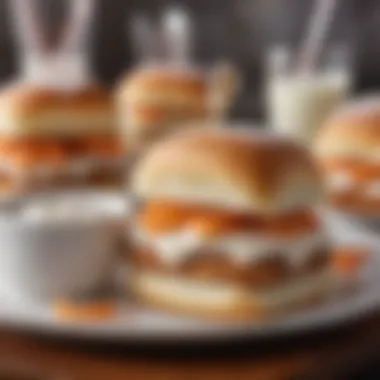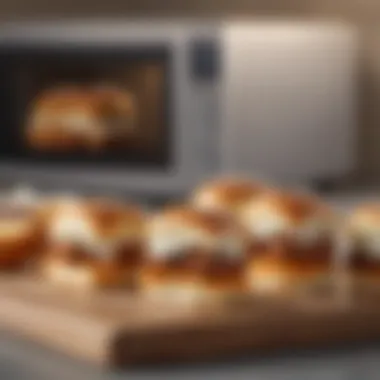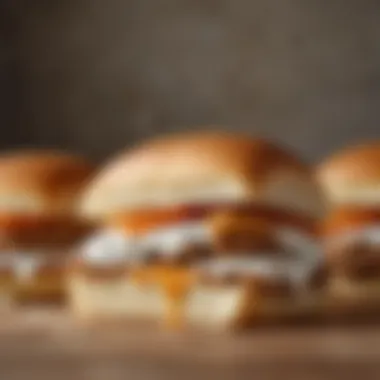Mastering the Art of Cooking White Castle Frozen Sliders


Intro
White Castle frozen sliders are a nostalgic and beloved food item for many. Preparing these sliders at home can recreate a taste often associated with late-night cravings or quick meals. This guide offers meticulous instructions to enhance your culinary exploration. You will find various methods for cooking, each with its considerations and optimal techniques. Understanding these facets ensures a rewarding cooking experience.
Ingredients Breakdown
Primary Ingredients
To achieve the classic flavor, start with the primary ingredients:
- White Castle frozen sliders
- Essential condiments (ketchup, mustard, pickles)
- Fresh toppings (lettuce, tomato, onion)
Optional Ingredients
Many cooks enhance sliders with other ingredients. These can include:
- Cheese
- Jalapeños
- Bacon bits
Essential Kitchen Tools
Proper tools contribute significantly to cooking success:
- Microwave, oven, or frying pan
- Baking sheet or skillet for frying
- Spatula for flipping
- Knife for chopping garnishes
Step-by-Step Preparation
Prepping the Ingredients
Before you begin cooking, it’s important to gather and prepare your ingredients. Remove the frozen sliders from their packaging. Additionally, wash and chop any fresh toppings if needed. Having everything on hand facilitates the cooking process.
Cooking Techniques and Methods
You can employ several methods for cooking White Castle frozen sliders:
- Microwave:
- Oven:
- Frying:
- Place sliders on a microwave-safe plate.
- Cover with a paper towel to prevent drying.
- Heat for about 2 minutes.
- Preheat the oven to 375°F (190°C).
- Place sliders on a baking sheet and cook for about 10-12 minutes.
- Flip halfway through for an even crisp.
- Heat oil in a skillet over medium heat.
- Place sliders in the skillet, frying for 2-3 minutes per side, until golden brown.
Assembly and Presentation Tips
Once cooked, arrange the sliders on a serving platter. Layers of toppings can elevate visual appeal. Serve with your choice of sides to create a satisfying meal. A specific attention to plate presentation can enhance the dining experience.
Dietary Considerations
Gluten-Free Options
For those observing gluten-free diets, consider using gluten-free buns or lettuce wraps. Check specific store offerings for suitable slider alternatives.
Vegetarian and Vegan Substitutes
There are growing options for vegetarians or vegans. Look for meatless versions or sliders made of vegetables. Some brands even offer plant-based patties that mimic the original taste.
Nutrition Facts & Nutritional Considerations
Keep an eye on portion sizes. While sliders are tasty, moderation can ensure a healthier balance. Refer to the packaging for specific nutritional values, which contain all necessary details to make informed choices.
Variations and Customizations
Flavor Enhancements
Tinkering with sliders can lead to delightful results. Try adding different sauces like barbecue or spicy mayo. Experiment with spices to alter the flavor profile.
Alternative Cooking Methods


In addition to the primary cooking methods, consider air-frying as a modern alternative. Air-fryers deliver a crispy texture without added fat.
Pairing Suggestions (Sides, Drinks, etc.
)
For an optimal meal experience, pair sliders with classic french fries, onion rings, or a fresh salad. Beverage options may include soda, iced tea, or milkshakes.
Common Questions and Answerss and Troubleshooting
Frequently Asked Questions
How long should I cook them? Generally, follow specific heating instructions provided on the packaging. Each method may vary slightly.
Common Mistakes to Avoid
Avoid directly cooking from frozen without proper thawing. Another common error is overcrowding the pan, which can prevent even cooking.
Solutions to Potential Problems
If sliders turn out too dry, consider adjusting the cooking time for next time. For burnt edges, lower the heat slightly and check frequently.
Preparing frozen sliders at home can be rewarding, as long as you adhere to proper cooking methods.
Preface to White Castle Frozen Sliders
The preparation of frozen sliders from White Castle represents a marriage between convenience and nostalgia for food lovers. With their unique taste, these sliders cater to those who seek quick meals without sacrificing flavor. Understanding how to properly prepare these frozen delights is vital for ensuring they taste as close to freshly made as possible. With various cooking methods available, each holds distinct advantages and caveats worth considering.
Overview of White Castle
White Castle is not just another fast-food chain. Established in 1921, it has carved a niche within American culture. It was one of the first chains to popularize the concept of small, square burgers, often celebrated as a late-night indulgence. These burgers, often referred to as sliders, speak to a wider audience beyond fast-food consumers. They appeal in part due to their cultural significance and also because they're an easy, satisfying meal option. As a brand, White Catle draws strong customer loyalty, as many relish its history and thought of convenience that comes with its offerings.
What Are Frozen Sliders?
Frozen sliders from White Castle are essentially pre-cooked burgers, packaged for consumer convenience. They feature a tiny size, pinned down with steamable soft buns, and a distinct beef patty. The sliders come with the essential condiments pre-added, often including onions and pickles, embodying the traditional White Castle flavor even in frozen form. Consumers can find them in most supermarkets, offering a taste of fast-food style eating while dining at home. The simplicity of preparation adds further appeal—giving food enthusiasts a glimpse of efficiency mixed with somewhat hearty satisfaction.
Popularity and Appeal
The popularity of White Castle frozen sliders can be attributed to multiple factors. First, they evoke a sense of nostalgia for many who grew up enjoying the original, fresh sliders. Consuming them at home acts as a bridge between past and present culinary experiences. Their small size offers flexibility for quick snacks or appetizers for larger gatherings. Moreover, their ease of cooking makes them an appealing option for those with busy lifestyles looking to satisfy cravings without elaborate food preparation. For college students, families, or busy professionals, these sliders represent both a comfort food and a practical choice for meals.
White Castle frozen sliders allow consumers to enjoy iconic fast food from their comforts of home, maintaining essential flavors with minimal effort.
Using their practicality, nostalgic quality, and ease, White Castle frozen sliders resonate with consumers, maintaining a unique spot within the new food landscape. They become more than just a meal—they morph into an experience tied deeply to the memories of fast dining, prompting repeated purchase and elevating home cooking to fulfilling satisfaction.
Cooking Methods for Frozen Sliders
Cooking Frozen Sliders from White Castle involves understanding various methods suitable for preparing them. Each method presents unique qualities that can influence flavor and texture. Knowing these can enhance the eating experience, making it enjoyable for all food lovers.
When choosing a cooking method, consider factors like time, effort, and desired taste. The microwave is often faster but might result in a softer texture. Conversely, oven cooking can yield a crispy finish but requires more time. Meanwhile, frying offers a deeply savory experience, although it may involve more steps and cleanup. Understanding these considerations will help you choose the method that fits your culinary needs.
Microwave Preparation
Using the microwave to prepare White Castle frozen sliders is a popular option. It provides convenience, enabling quicker preparation compared to other methods.
Step-by-Step Microwave Instructions
- Remove frozen sliders from their packaging.
- Place them on a microwave-safe plate.
- Cover them loosely with a paper towel to prevent splatter.
- Heat on high for approximately 60-70 seconds.
- Check if heated through. If not, continue heating in 10-second increments.
Using this method is often beneficial because it does not require much time and makes for an easy cooking process. Overall, it emphasizes convenience without sacrificing much flavor for those with hectic lifestyles. However, the texture may not replicate the grilled quality of a slider from a restaurant, which some enthusiasts might miss.
Tips for Optimal Texture
To achieve the best texture in microwave cooking, consider the following:
- Allow the sliders to stand for one minute after microwaving. This helps redistribute moisture.
- Ensure they are loaded evenly in the microwave, as overlapping can lead to uneven cooking.
These tips improve the overall experience by mitigating sogginess, a common gravitation in microwave cooking. While the microwave delivery method is efficient, there may be flavor depth lost compared to other methods.


Oven Method
Oven cooking continues to be favored by many. It is excellent for producing a uniformly crispy exterior.
Step-by-Step Oven Instructions
- Preheat your oven to 350°F (175°C).
- Remove the sliders from packaging and arrange them on a baking sheet.
- Bake for about 12 minutes.
- Flip them halfway through for even crispness.
Following this procedure focuses on achieving a pleasing texture while ensuring precise temperature control. Oven baking provides restored flavor while also promoting even cooking.
Recommended Cooking Times and Temperatures
Optimal cooking takes commitment to proper times and temperatures. Aim for:
- Preheating the oven to 350°F (175°C) before placing the sliders.
- Maintaining cooking times between 10 and 12 minutes, with checking at halfway mark.
Observing recommended cooking details allows sliders to reach the desired textures and flavors. It may involve more time than other methods, but the crispy outcome is worth it, especially for those who delight in robust flavor.
Frying Option
Frying is a method that may take additional effort, but the results often pay dividends.
Step-by-Step Frying Instructions
- Heat about half an inch of oil in a skillet over medium heat.
- Carefully place the frozen sliders in the hot oil.
- Fry for about 3-4 minutes on each side, until golden brown.
- Remove and let drain on paper towels.
Frying gives burgers an incredibly satisfying crispiness and allows spices to emerge. While it requires more oversight, repeat use presents the opportunity to enhance culinary skills and intermingle flavors.
Safety Precautions
Cooking with hot oil does present risks. It’s vital to adhere to these precautionary steps:
- Use a thermometer to ensure that oil reaches at least 350°F (175°C).
- Never leave hot oil unattended while cooking.
- Keep flammable materials away from your cooking area.
These measures ensure not just safety but also promote cooking efficacy. Abiding by guidelines keeps the cooking environment secure for optimal future culinary endeavors.
Essential Considerations Before Cooking
When preparing White Castle frozen sliders, understanding essential considerations before you begin cooking is vital to ensure the best possible outcome. It’s more than just a simple warming up of food; the method, moisture retention, and ingredients play key roles in the eating experience. Paying close attention to the process and preparation significantly contributes to taste, texture, and even nutrition.
Thawing vs.
Cooking from Frozen
Thawing sliders before cooking can be a game changer. When sliders are cooked from frozen, they tend to retain more moisture, leading to a different eating experience. Cooking from frozen may result in a firmer texture, whereas thawing them might offer a softer, more appealing bite. The time taken to thaw should be factored into your overall cooking strategy, especially if you choose to steam or add toppings post-cooking.
However, if time is limited or you desire a quicker meal, cooking directly from frozen remains a viable option. In either case, knowing the difference helps you to achieve the desired result, whether it's crispy edges or a gooey inner layer. It is important to consult package instructions because each brand may suggest different strategies based on their formulation.
Ingredient Considerations
Potential Allergens
When dealing with frozen sliders, it’s essential to consider potential allergens. Common allergens include wheat, dairy, and soy. White Castle sliders usually highlight these main allergens on their packaging. For individuals with allergies, this awareness can prevent unexpected reactions and discomfort, making it a critical aspect of preparation that cannot be overlooked.
Each person's tolerance to these ingredients varies. Knowing what is in your food allows for safe choices tailored to dietary needs or restrictions. Reading about allergens helps to make sound decisions regarding modifications or substitutions, especially when preparing additional toppings or sides.
Nutrition Information
Nutrition information continues to be a vital focus for the health-conscious consumer. White Castle sliders may vary in calories, fat content, and sodium levels. Each slider’s macros contribute overall to your meal plan, whether that’s fit for casual indulgence or a healthier snack alternative. Understanding the nutritional profile assists you in assessing your choices in the bigger context of daily ideals.
Generally, sliders are considered a comfort food. However, being mindful of its packaging about calories and uncommon ingredients can inform better decisions. Many consumers appreciate knowing how their food fits into nutritional goals. Properly checking these details encourages informed choices and promotes satisfied eating.
Understanding ingredient characteristics and allergen information enhances the cooking experience and dining satisfaction.
Overall, comprehending these aspects ensures a successful cooking endeavor. A mindful approach to thawing, ingredients, and insights into allergen safety create foundations for great sliders, tailored to fit your needs.
Serving Suggestions for Sliders


The way White Castle frozen sliders are served can greatly enhance the overall eating experience. It’s not just about the sliders themselves; accompaniments, presentation, and flavors greatly contribute to how satisfactory the meal is for the consumer. Serving suggestions point out the possible partnerships of flavors that can elevate the tasting elements of the sliders. Knowing how to serve them properly may bring a new dimension to enjoying an iconic fast-food memory, especially for those who regard food as a significant part of lifestyle.
Classic Accompaniments
When considering traditional serving items for sliders, a few classics come to mind. These items complement the flavors of the sliders and provide additional texture and taste.
- Pickles: Adding dill pickles on the side introduces a zingy taste that balances the richness of the slider.
- Onion Rings: A few crispy onion rings contribute texture and can bring a robust flavor that mingles well with the slider's profile.
- Fries: Common fries can serve as a beloved side; consider crinkle-cut fries for the perfect crunch. They also hold up well against sauces and dips.
Additionally, one might choose to serve sliders in a basket, giving a rustic fast-food feel, while also managing several sides. This strategy makes it easy for diners to sample more than one flavor at a time, promoting a casual and fun dining atmosphere.
”The best accompaniments not only provide different textures but also complement the overall flavor of the dish.”
Creative Twists
For those who appreciate culinary exploration, there are alternatives to the classic toppings and sides. Improving traditional serving methods can lead to distinctive eating adventures. Here are a few suggestions:
- Sauces: Elevate your sliders by introducing spicy mayo, chipotle sauce, or even a ginger garlic glaze to that decadent bite. These will certainly add a burst of flavor.
- Coleslaw: Adding a bit of creamy coleslaw on top of the slider could provide a cool contrast to the warm, moist sandwich.
- Gourmet Cheese: Instead of standard cheese, try swapping it with blue cheese or pepper jack, enhancing the sliders' flavor.
- Avocado Slices: Adding slices of creamy avocado gives richness and rarity that keeps taste buds intrigued. Plates may be dressed less traditionally incorporating colorful elements like sliced/colors such as lightly roasted peppers or even peppadew.
Creative presentation also matters. Arranging sliders gourmet-style along with colorful accompaniments can elevate the visual dining experience. Use smaller plates or unique serving dishes to emphasize the sliders as a centerpiece.
Through careful consideration of both accompany elements and layering flavors, White Castle frozen sliders can truly shine within an exciting meal framework.
Common Mistakes to Avoid
In preparing White Castle frozen sliders, familiarity with common mistakes is critical. Learning what to avoid ensures successful cooking and a rewarding taste experience. Understanding these pitfalls enhances your culinary confidence and elevates the household meal enjoyment.
Overcooking
Overcooking sliders is a prevalent error that can diminish taste and texture. When sliders are exposed to high heat for too long, they lose moisture. This results in a dry, unappetizing product. Instead of the desired soft and juicy bites, overcooked sliders become tough and seem uninviting.
It is vital to adhere to precise cooking times specified on the packaging. Since every device differs regarding cooktop temperatures and power, keep an eye on your timings during preparations. If losing track is a concern, using a kitchen timer might help.
To achieve the best results, consider using the following guidelines:
- Use a thermometer: Cook sliders to an internal temperature of 165°F (74°C) for optimal safety and quality.
- Check at intervals: For microwave or oven methods, start monitoring a minute or two before the suggested cooking time ends to avoid surprises.
By avoiding overcooked sliders, you will better appreciate the experience White Castle frozen sliders can offer.
Ignoring Package Instructions
Ignoring the printed instructions on the package may contribute to less than par results. Many home cooks overlook this important detail in the eagerness to taste their meal. However, these guidelines are based on trials and formulated carefully to produce the best product possible.
Package instructions typically include suggested preparation methods, optimal temperatures and times, and details regarding serving sizes. Ignoring these instructions can lead to undesirable outcomes like uneven cooking or texture inconsistencies.
To maximize Sandy your White Castle frozen sliders enjoyment, always take time to read:
- Cooking methods presented as suitable for microwave, oven, or frying. Each method has different nuances and timing.
- Recommended heating times to achieve optimal results regardless of choice of method.
When you adhere to the packaging instructions, your sliders can reach their fullest potential, ensuring tasting satisfaction with every bite.
Proper preparation leads to profound enjoyment, so avoid shortcuts that sacrifice flavor and quality.
Finale
The concluding section underscores the vital role that mastering the art of cooking White Castle frozen sliders plays in enhancing both the culinary experience and enjoyment of this beloved fast food icon. Understanding the various preparation methods and the key tips associated with each can significantly impact the taste and quality of the finished product. This clarity not only aids in successful execution but also maximizes satisfaction, leading to a more enjoyable meal.
> Mastering the preparation of White Castle frozen sliders is essential for an experience that mirrors the original intent of these iconic burgers.
Summary of Best Practices
A precise recipe will not suffice if best practices are overlooked. Here are several key points to consider:
- Follow Cooking Instructions: Always refer to package directions when cooking frozen sliders. These guidelines are tailored for optimal results, ensuring that every slider achieves the perfect balance of warmth and texture.
- Utilize Kitchen Thermometers: Use a food thermometer to verify that the inside temperature reaches the recommended 165°F (74°C). This ensures safe food handling and quality.
- Avoid Overcrowding Cooking Surfaces: When cooking multiple sliders at once, ensure enough space between each to allow for even heat distribution. This will help avoid an uneven cooking experience.
- Let Them Rest: Once cooked, allow the sliders to sit for a minute or two. This can help juices redistribute, resulting in a better bite.
These practices pave the way for an enhanced culinary experience, allowing sliders to shine in their rightful place as a satisfying treat.
Encouragement for Experimentation
While the guidelines provide a solid foundation for preparation, there is immense value in modulatin gone’s approach. Experimenting with different methods can yield textiles and tastes that delight the palate in unexpected ways. Consider the following:
- Explore Different Sauces: Try adding variety. A hint of spicy mayo or special sauce could elevate the flavors further.
- Test Various Cheese Types: Melt some American cheese for classic style or switch it to pepper jack for an extra kick.
- Adjust Cooking Times: Depending on your device, monitoring the sliders and adjusting time could consistently deliver better results.
By embracing creativity in cooking, one can transform the seemingly mundane act of preparing frozen sliders into an adventure filled with flavors. This encourages deeper culinary exploration and learning.







